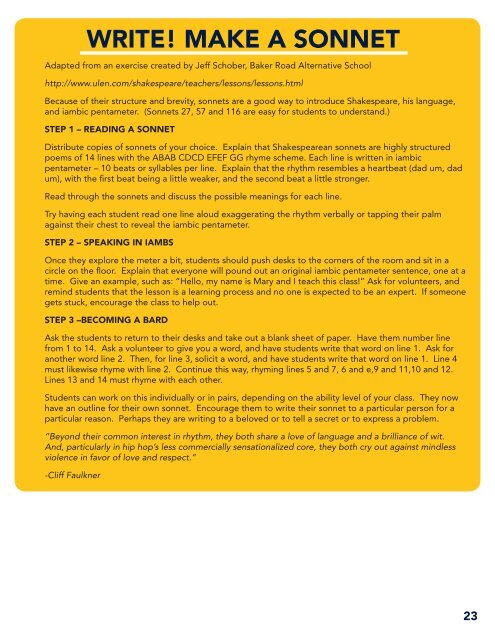SHAKESPEARE: THE REMIX
SHAKESPEARE: THE REMIX
SHAKESPEARE: THE REMIX
You also want an ePaper? Increase the reach of your titles
YUMPU automatically turns print PDFs into web optimized ePapers that Google loves.
WRITE! MAKE A SONNET<br />
Adapted from an exercise created by Jeff Schober, Baker Road Alternative School<br />
http://www.ulen.com/shakespeare/teachers/lessons/lessons.html<br />
Because of their structure and brevity, sonnets are a good way to introduce Shakespeare, his language,<br />
and iambic pentameter. (Sonnets 27, 57 and 116 are easy for students to understand.)<br />
STEP 1 – READING A SONNET<br />
Distribute copies of sonnets of your choice. Explain that Shakespearean sonnets are highly structured<br />
poems of 14 lines with the ABAB CDCD EFEF GG rhyme scheme. Each line is written in iambic<br />
pentameter – 10 beats or syllables per line. Explain that the rhythm resembles a heartbeat (dad um, dad<br />
um), with the first beat being a little weaker, and the second beat a little stronger.<br />
Read through the sonnets and discuss the possible meanings for each line.<br />
Try having each student read one line aloud exaggerating the rhythm verbally or tapping their palm<br />
against their chest to reveal the iambic pentameter.<br />
STEP 2 – SPEAKING IN IAMBS<br />
Once they explore the meter a bit, students should push desks to the corners of the room and sit in a<br />
circle on the floor. Explain that everyone will pound out an original iambic pentameter sentence, one at a<br />
time. Give an example, such as: “Hello, my name is Mary and I teach this class!” Ask for volunteers, and<br />
remind students that the lesson is a learning process and no one is expected to be an expert. If someone<br />
gets stuck, encourage the class to help out.<br />
STEP 3 –BECOMING A BARD<br />
Ask the students to return to their desks and take out a blank sheet of paper. Have them number line<br />
from 1 to 14. Ask a volunteer to give you a word, and have students write that word on line 1. Ask for<br />
another word line 2. Then, for line 3, solicit a word, and have students write that word on line 1. Line 4<br />
must likewise rhyme with line 2. Continue this way, rhyming lines 5 and 7, 6 and e,9 and 11,10 and 12.<br />
Lines 13 and 14 must rhyme with each other.<br />
Students can work on this individually or in pairs, depending on the ability level of your class. They now<br />
have an outline for their own sonnet. Encourage them to write their sonnet to a particular person for a<br />
particular reason. Perhaps they are writing to a beloved or to tell a secret or to express a problem.<br />
“Beyond their common interest in rhythm, they both share a love of language and a brilliance of wit.<br />
And, particularly in hip hop’s less commercially sensationalized core, they both cry out against mindless<br />
violence in favor of love and respect.”<br />
-Cliff Faulkner<br />
23



